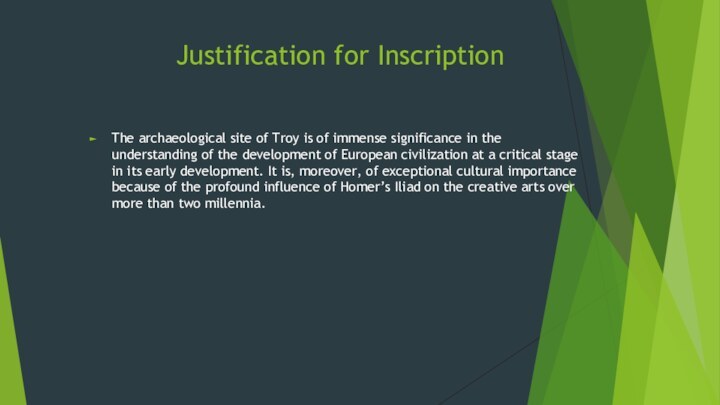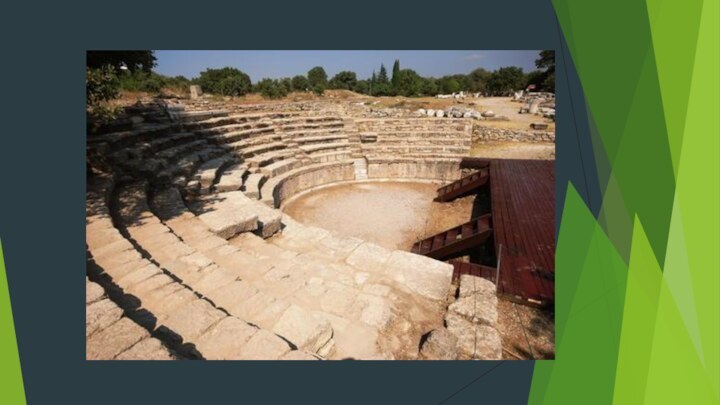- Главная
- Разное
- Бизнес и предпринимательство
- Образование
- Развлечения
- Государство
- Спорт
- Графика
- Культурология
- Еда и кулинария
- Лингвистика
- Религиоведение
- Черчение
- Физкультура
- ИЗО
- Психология
- Социология
- Английский язык
- Астрономия
- Алгебра
- Биология
- География
- Геометрия
- Детские презентации
- Информатика
- История
- Литература
- Маркетинг
- Математика
- Медицина
- Менеджмент
- Музыка
- МХК
- Немецкий язык
- ОБЖ
- Обществознание
- Окружающий мир
- Педагогика
- Русский язык
- Технология
- Физика
- Философия
- Химия
- Шаблоны, картинки для презентаций
- Экология
- Экономика
- Юриспруденция
Что такое findslide.org?
FindSlide.org - это сайт презентаций, докладов, шаблонов в формате PowerPoint.
Обратная связь
Email: Нажмите что бы посмотреть
Презентация на тему Archaeological Site of Troy
Содержание
- 2. Archaeological Site of TroyTroy, with its 4,000
- 3. Included in the UNESCO World Heritage List
- 4. Justification for Inscription The archaeological site of
- 6. Nine main layers of ancient TroyKumtepa or
- 7. DescriptionHuman occupation on the site of Troy
- 9. Historical Description Human occupation on the site
- 12. Скачать презентацию
- 13. Похожие презентации
Archaeological Site of TroyTroy, with its 4,000 years of history, is one of the most famous archaeological sites in the world. The first excavations at the site were undertaken by the famous archaeologist Heinrich Schliemann in












Слайд 4
Justification for Inscription
The archaeological site of Troy is
of immense significance in the understanding of the development
of European civilization at a critical stage in its early development. It is, moreover, of exceptional cultural importance because of the profound influence of Homer’s Iliad on the creative arts over more than two millennia.
Слайд 6
Nine main layers of ancient Troy
Kumtepa or Troy
0 - Neolithic settlement that existed in the area
of Troy.Troy I (3000-2600 . BC. E.): The first Trojan settlement, 100 m in diameter, was built on a very primitive dwellings of mud bricks. Judging by the remaining traces of it were lost in a fire. Pottery has similarities with pottery culture Jezero in Bulgaria.
Troy II (2600-2300 . BC. E.): The next village is more developed and rich. In 1873, the German archaeologist Schliemann discovered in this layer the famous Trojan treasure, which consisted of numerous weapons, copper trinkets, pieces of jewelry, gold vessels, gravestones prehistoric period. In the III millennium BC. e. This highly developed culture was also destroyed by fire.
Troy III-IV-V (2300-1900 . BC. E.): These layers show a period of decline in the history of the ancient city.
Troy VI (1900-1300 . BC. E.): City increased in diameter up to 200 meters. The settlement became the victim of a major earthquake in 1300 BC. e.
Troy VII-A (1300-1200 . BC. E.): This period is the famous Trojan War. Later, the Athenians plundered and destroyed the settlement.
Troy VII-B (1200-900 years. BC. E.): Dilapidated Troy was captured Phrygians.
Troy VIII (900-350 . BC. E.) At this time, the city was inhabited by Greeks. King Xerxes then went to Troy and brought here to sacrifice more than 1,000 head of cattle.
Troy IX (350 BC. E. - 400 AD. E.): Quite a large center of the Hellenistic era
Слайд 7
Description
Human occupation on the site of Troy began
in the early Bronze Age. The first defensive wall
round the citadel was built around 3000 BC. Then Troy VI expanded, making it one of the largest towns in the Aegean region with an important trading role. An earthquake in 1350 BC caused grave damage to Troy VI, but the town quickly recovered and was rebuilt in a more orderly layout. The evidence of widespread fire and slaughter around 1250 BC, which brought Troy VII to an end, has led to this phase being identified with the city besieged by the Greeks during the Trojan War, immortalized in The Iliad . The real cause of the Trojan war was intense commercial rivalry between Troy and the mercantile Mycenaean kingdom, the prize being control of the Dardanelles and the lucrative trade with the Black Sea. In 306 BC, Troy became the capital of a league of cities in the Troad and in 188 BC it was identified by the Romans as the Ilion of Homer and recognized as the mother-city of Rome. The town prospered under Roman rule and survived a severe earthquake in the early 6th century. Abandoned once again in the 9th century, it was reoccupied in the later Byzantine period and not finally deserted until well into the Ottoman period.The contemporary history of the site and its subsequent exploration and conservation dates from 1793, when it was discovered. It was identified by scholars, first as Ilion in 1810 and then as Troy in 1820. Heinrich Schliemann first visited the site in 1868. Between then and his death in 1890 he carried out seven major campaigns, completed in 1893-94 by his assistant, Wilhelm Dörpfeld. It was in 1873 that he found the famous gold hoard, known erroneously as 'King Priam's Treasure', as it came from Troy II, not Troy VIIA. Excavations over more than a century have revealed 23 sections of the defensive walls around the citadel, eleven gates, a paved stone ramp, and the lower portions of five defensive bastions. These date for the most part from Troy II and VI; however, a section of the earliest wall (Troy I) survives near the south gate of the first defences. The great residential complex from Troy II consists of five parallel long buildings with porches. The largest of these is considered to represent the prototype of the Greek temple. The ensemble is considered to have constituted some form of palace. The remains of a number of long rectangular houses from Troy II are to be seen at the bottom of one of the most striking features off the site, the so-called Schliemann Trench, dug by the famous 19th-century excavator in search of the 'Citadel of Priam', the object of his search.
Слайд 9
Historical Description
Human occupation on the site of Troy
(Ilion) began in the Early Bronze Age (late 4th
millennium BC). The first defensive wall round the citadel was built around 3000 BC and expanded twice, attaining a diameter of c 110m at the end of Phase I, around 2500 BC.There was steady development and regularization of the settlement plan in the following five centuries (Troy IIV) to the end of the Early Bronze Age. Around 2000 BC there was a dramatic cultural change, with reconstruction of houses and walls in stone. The town expanded considerably outside the original walled settlement, and Troy VI (from c 1700 BC) may have covered the entire plateau, making it one of the largest towns in the Aegean region. Goods imported from Mycenae and elsewhere in Greece give an indication of its important trading role.
An earthquake in c 1350 BC caused grave damage to Troy VI, with defensive walls and houses collapsing, but the town quickly recovered and was rebuilt in a more orderly layout. The evidence of widespread fire and slaughter around 1250 BC, which brought Troy VIIA to an end, has led to this phase being identified with the city besieged by the Greeks during the Trojan War, immortalized in The Iliad. What is known of the economic and political history of the Aegean region in this period suggests that the real cause of the Trojan War was intense commercial rivalry between Troy and the mercantile Mycenaean kingdom, the prize being control of the Dardanelles and the lucrative trade with the Black Sea.
The town was to be rebuilt once again, but Bronze Age Troy, having most likely lost its commercial supremacy, had been abandoned by the end of the 2nd millennium BC. The site was reoccupied by Greek settlers from Lemnos in the 8th century BC (Troy VIII), and it assumed considerable importance in 306 BC as the capital of a league of cities in the Troad.
In 188 BC it was identified by the Romans as the Ilion of Homer and recognized as the mother-city of Rome (Ilium Novum), being granted exemption from taxes. It was sacked in 85 BC during the Mithridatic War and not rebuilt until around 20 BC, following a visit by Augustus. The town prospered under Roman rule, despite being devastated by Herulian raiders in AD 267, and survived a severe earthquake in the early 6th century. Abandoned once again in the 9th century, it was reoccupied in the later Byzantine period and not finally deserted until well into the Ottoman period.





























